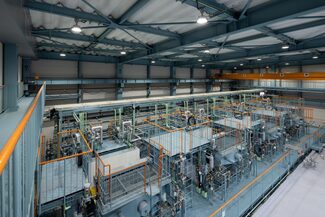The Hydrogen Stream: Asahi Kasei to Test Alkaline Water Electrolyzer
Japan's Asahi Kasei is testing a new alkaline water electrolyzer, while China has started developing its first 100 kg
PV Magazine International 5:33 pm on May 14, 2024

pv magazine highlights Asahi Kasei's testing of a new 100 MW-class alkaline water electrolyser for green hydrogen production in Japan and China CASC's development of the first 100 k vehicle-mounted liquid hydrogen system. Additionally, Fortescue unveils its US $550 million green hydrogen venture aiming to reduce carbon emissions through renewable energy investments.
- Asahi Kasei's Test: Japan's Asahi Kasei is pioneering a new large-scale alkaline water electrolyser for green hydrogen production with an anticipated capacity of over 100 MW.
- China CASC's Innovation: China Aerospace Science and Technology Corporation (CASC) has introduced the first vehicle-mounted liquid hydrogen system capable of supporting long distances, signaling a significant advancement in green transport solutions.
- Fortescue's US Expansion: Fortescue Mining Group commences its foray into green hydrogen production with a $550 million investment in the United States, highlighting global growth in renewable energy initiatives.
- Global Hydrogen Summit: New Mexico's participation undersc Cooktops and Ovens - Types and Usage
Cooktops and ovens are essential appliances found in most homes, restaurants, and commercial kitchens. They come in various types, each designed for specific cooking methods or purposes. Below is a detailed explanation of the different kinds of cooktops and their uses:
1. Gas Cooktops:
Gas cooktops are powered by natural gas or propane and have an open flame as their heat source. They provide precise control over temperature, making them ideal for chefs who need to adjust the heat quickly during cooking. Common types include:
- Induction Cooktops: These use magnetism to directly heat pots and pans without heating the surface itself. They are energy-efficient, safe (no open flame), and provide rapid temperature control.
- Traditional Gas Stoves: Also known as "knobs," these cooktops have individual burners that can be adjusted independently to achieve specific heat levels. The flame is visible, making it easier for users to monitor the process.
2. Electric Cooktops (Coils and Induction):
- Coil Cooktops: Also known as electric stoves or range cooktops, these have exposed heating elements that warm up pots and pans placed directly on top of them. They are less expensive than other types but may take longer to heat up and cool down compared to induction cooktops.
- Induction Cooktops: As mentioned above, they use electromagnetic fields to generate a high-frequency current that heats the pan directly while keeping the surface cool.
- Ceramic Glass Cooktops: These have a smooth glass or metal surface over an electric coil cooking element below it. They offer easy temperature control and are usually cheaper than induction cooktops but consume more energy.
3. Combination Cooktop Ovens:
Also called convection ovens, these appliances combine the features of both a conventional stovetop (gas or electric) with an oven for baking, broiling, and roasting. They offer versatayer's guide to choosing the right type of cooktop based on your needs.
- If you prioritize precision and safety while frequently using recipes that demand quick temperature adjustments, consider investing in a gas or induction stovetop. Gas ranges tend to be more affordable but require proper ventilation to mitigate any potential risks associated with the open flame. Electric coil or ceramic glass cooktops offer decent performance and are ideal for those seeking budget-friendly options, though they may lack the convenience of fast heat adjustment.
- Induction cooktops excel in offering energy efficiency, precise temperature control, safety due to no open flame, easy cleaning (as soils on pans do not transfer onto surfaces), and quiet operation making them suitable for various settings such as households, commercial kitchens, or restaurants.
- Convection ovens are beneficial when baking breads, cakes, cookies, or other items that require even heat distribution within the enclosed chamber. They also allow you to cook a larger quantity of food simultaneously while preserving energy compared to standard electric ovens with top and bottom heating elements.
- If space is limited and you need both stovetop and oven functions in one appliance, look for combination cooktop/oven models that suit your needs without overwhelming the kitchen's layout.
When selecting a cooktop, it's essential to consider factors like fuel source (gas or electric), type of burner, desired features, space availability, budget constraints, and energy efficiency. Consulting with professionals at an appliance store can help you make the best choice for your specific requirements.
https://www.pv-magazine.com/2024/05/14/the-hydrogen-stream-asahi-kasei-to-test-alkaline-water-electrolyzer/< Previous Story - Next Story >